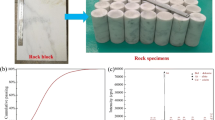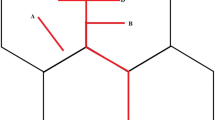Abstract
Understanding the microcrack nucleation is of a fundamental importance in the study of rock fracturing process. Due to variations in texture and mineralogy, different rocks may show different distinctive microcrack nucleation mechanisms. In order to understand the microcrack nucleation mechanisms in Carrara marble comprehensively, localized damage zones are artificially produced by loading specimens containing an array of en-echelon flaws in this study. Then, representative samples were cut from those loaded specimens and prepared for optical observation. Four types of microcrack nucleation mechanisms leading to the formation of transgranular cracks have been identified in Carrara marble. Type I and II mechanisms are favored by the distinctive polygonal shape of the crystal grains in Carrara marble. Local tensile stress concentration in these two mechanisms is attributed to grain sliding and divergent normal contact force, respectively. Type III mechanism is associated with the gliding along twin lamellae. The resultant tensile stress concentration could nucleate microcracks within the grain containing these lamellae or in the grain boundary. No microcracks in the adjoining grains were observed in this study. Our statistical analysis suggests that type III mechanism favors the nucleation of new cracks which are nearly perpendicular to the gently inclined twin lamellae and thus have a small angle with the maximum loading direction (about 15°). Type IV mechanism operates in grains failed mainly due to compressive stress rather than tensile stress concentration. Sets of parallel microcracks of this mechanism seem to be related to the crystallographic planes of calcite. The microcracking results also suggest that most of the grain boundaries in damaged zone have been cracked at the loading about 80 % of the specimen strength, while transgranular cracks begin to occur at that time and flourish after about 90 % loading of the strength.









Similar content being viewed by others
References
Alber M, Hauptfleisch U (1999) Generation and visualization of microfractures in Carrara marble for estimating fracture toughness, fracture shear and fracture normal stiffness. Int J Rock Mech Min Sci 36:1065–1071. doi:10.1016/S1365-1609(99)00069-6
Ashby MF, Sammis CG (1990) The damage mechanics of brittle solids in compression. Pure appl Geophys 133:489–521
Brace W, Paulding B, Scholz C (1966) Dilatancy in the fracture of crystalline rocks. J Geophys Res 71:3939–3953
Conrad Ii RE, Friedman M (1976) Microscopic feather fractures in the faulting process. Tectonophysics 33:187–198. doi:10.1016/0040-1951(76)90056-1
DiGiovanni A, Fredrich J, Holcomb D, Olsson W (2007) Microscale damage evolution in compacting sandstone. Geol Soc Lond Spec Publ 289:89–103
Dunn DE, LaFountain LJ, Jackson RE (1973) Porosity dependence and mechanism of brittle fracture in sandstones. J Geophys Res 78(14):2403–2417
Edmond J, Paterson M (1972) Volume changes during the deformation of rocks at high pressures. Int J Rock Mech Min Sci Geomech Abstr 9:161–182
Frank F, Lawn BR (1967) On the theory of Hertzian fracture. In: Proceedings of the Royal Society of London A: Mathematical, Physical and Engineering Sciences, The Royal Society
Fredrich JT, Evans B, Wong TF (1989) Micromechanics of the brittle to plastic transition in Carrara marble. J Geophys Res 94:4129–4145
Friedman M, Logan JM (1970) Microscopic feather fractures. Geol Soc Am Bull 81:3417–3420
Gamond J (1987) Bridge structures as sense of displacement criteria in brittle fault zones. J Struct Geol 9:609–620
Kim Y-S, Peacock DCP, Sanderson DJ (2003) Mesoscale strike-slip faults and damage zones. J Struct Geol 25:793–812
Kranz RL (1979) Crack growth and development during creep of Barre granite. Int J Rock Mech Min Sci Geomech Abstr 16:23–35. doi:10.1016/0148-9062(79)90772-1
Lajtai E (1971) A theoretical and experimental evaluation of the Griffith theory of brittle fracture. Tectonophysics 11:129–156
Menéndez B, Zhu W, Wong T-F (1996) Micromechanics of brittle faulting and cataclastic flow in Berea sandstone. J Struct Geol 18:1–16
Moore DE, Lockner DA (1995) The role of microcracking in shear-fracture propagation in granite. J Struct Geol 17:95–114
Nicksiar M, Martin CD (2013) Crack initiation stress in low porosity crystalline and sedimentary rocks. Eng Geol 154:64–76. doi:10.1016/j.enggeo.2012.12.007
Nolen-Hoeksema RC, Gordon RB (1987) Optical detection of crack patterns in the opening-mode fracture of marble. Int J Rock Mech Min Sci Geomech Abstr 24:135–144. doi:10.1016/0148-9062(87)91933-4
Olsson WA, Peng SS (1976) Microcrack Nucleation in Marble. Int J Rock Mech Min Sci Geomech Abstr 13:53–59
Rigopoulos I, Tsikouras B, Pomonis P, Hatzipanagiotou K (2011) Microcracks in ultrabasic rocks under uniaxial compressive stress. Eng Geol 117:104–113. doi:10.1016/j.enggeo.2010.10.010
Schedl A, Kronenberg AK, Tullis J (1986) Deformation microstructures of Barre granite: an optical, Sem and Tem study. Tectonophysics 122:149–164. doi:10.1016/0040-1951(86)90164-2
Seo YS, Jeong GC, Kim JS, Ichikawa Y (2002) Microscopic observation and contact stress analysis of granite under compression. Eng Geol 63:259–275. doi:10.1016/S0013-7952(01)00086-2
Sprunt ES, Brace WF (1974) Direct observation of microcavities in crystalline rocks. Int J Rock Mech Min Sci Geomech Abstr 11:139–150. doi:10.1016/0148-9062(74)92874-5
Tapponnier P, Brace W (1976) Development of stress-induced microcracks in Westerly granite. Int J Rock Mech Min Sci Geomech Abstr 13:103–112
Turner FJ, GRIGGS D, Heard H (1954) Experimental deformation of calcite crystals. Geol Soc Am Bull 65:883–934
Vajdova V, Zhu W, Natalie Chen T-M, T-f Wong (2010) Micromechanics of brittle faulting and cataclastic flow in Tavel limestone. J Struct Geol 32:1158–1169
Vajdova V, Baud P, Wu L, T-f Wong (2012) Micromechanics of inelastic compaction in two allochemical limestones. J Struct Geol 43:100–117. doi:10.1016/j.jsg.2012.07.006
Wong TF (1982) Micromechanics of faulting in westerly granite. Int J Rock Mech Min Sci Geomech Abstr 19:49–64. doi:10.1016/0148-9062(82)91631-X
Wong LNY, Einstein HH (2009) Crack coalescence in molded gypsum and Carrara marble: part 2—microscopic observations and interpretation. Rock Mech Rock Eng 42:513–545. doi:10.1007/s00603-008-0003-3
Wong TF, David C, Zhu W (1997) The transition from brittle faulting to cataclastic flow in porous sandstones: Mechanical deformation. J Geophys Res 102:3009–3025
Zhang S, Paterson MS, Cox SF (2001) Microcrack growth and healing in deformed calcite aggregates. Tectonophysics 335:17–36. doi:10.1016/S0040-1951(01)00043-9
Zhu W, Baud P, Vinciguerra S, T-f Wong (2011) Micromechanics of brittle faulting and cataclastic flow in Alban Hills tuff. J Geophys Res. doi:10.1029/2010jb008046
Acknowledgments
The research was supported by the Singapore Academic Research Fund Tier 1 Grant under project RG112/14 and the Nanyang Technological University Start Up Grant (M4080115.030).
Author information
Authors and Affiliations
Corresponding author
Rights and permissions
About this article
Cite this article
Cheng, Y., Wong, L.N.Y. & Maruvanchery, V. Transgranular Crack Nucleation in Carrara Marble of Brittle Failure. Rock Mech Rock Eng 49, 3069–3082 (2016). https://doi.org/10.1007/s00603-016-0976-2
Received:
Accepted:
Published:
Issue Date:
DOI: https://doi.org/10.1007/s00603-016-0976-2




